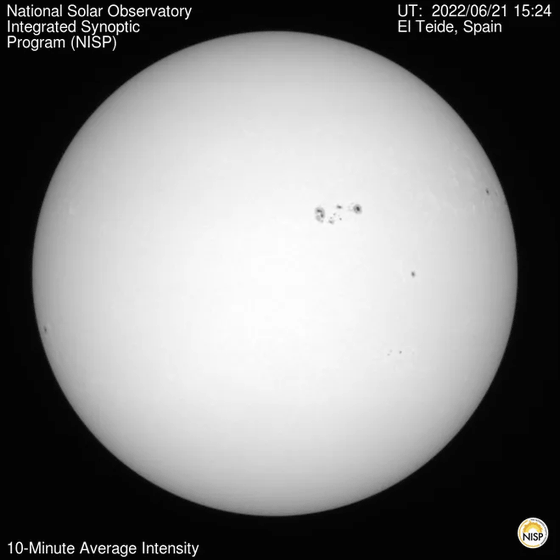Huge sunspots that double in size in one day are facing the earth, and there is a possibility that telephone lines and the Internet will be cut off.

Sunspots on the Earth's side can cause
Giant sunspot points toward Earth:'No need to panic,' experts say
https://www.usatoday.com/story/news/nation/2022/06/21/sunspot-solar-flare-earth-nasa/7687972001/
Giant Sunspot Has Doubled in Size in 24 Hours and It's Pointed at Earth
https://www.newsweek.com/sunspot-surface-sun-doubles-size-solar-flare-earth-1717343
A Massive Solar Flare Can Affect Everyone's Electricity, Phones Even the Internet | Nature World News
https://www.natureworldnews.com/articles/51459/20220620/massive-solar-flare-affect-everyone-s-electricity-phones-even-internet.htm
Rob Stenberg, head of the Space Weather Bureau within the US National Oceanic and Atmospheric Administration , said the sunspot, called the 'AR3038,' has swelled enormously in a week. However, regarding the size and growth rate of sunspots, Stenberg says it is 'quite normal.' According to Stenberg, sunspots generally grow over time, undergo gradual growth, and then collapse.
According to NASA , sunspots appear darker because they are cooler than the rest of the sun's surface. More specifically, it seems that a strong magnetic field is formed so as to prevent the heat in the sun from reaching the surface, and the temperature becomes low, resulting in sunspots. 'Simply put, sunspots are magnetically active areas,' Stenberg said.

by
Solar flares emanating from sunspots are sudden explosions of energy caused by entanglement, crossing, or reorganization of magnetic lines of force near sunspots. Regarding solar flares, Stenberg said, 'You can describe it as a twist of a rubber band. If you put some rubber bands on your fingers and entangle them, the rubber bands will eventually twist too much and break. The difference is that they can reconnect. In the process of this reconnection, flares occur. '
The larger and more complex the sunspots, the more likely it is that solar flares will occur. The 'AR3038' observed this time is as follows.

Alex Young, Deputy Director of Science at NASA's
'Sunspots produce small solar flares, but they are not the largest solar flares,' Young said. In addition, 'AR3038' has a 30% chance of producing a medium-sized solar flare, and a 10% chance of producing a large-sized solar flare.
Dean Pesnell, a scientist at the Solar Dynamics Observatory at NASA, said of the AR3038, 'It's not unusually fast growing, it's a little smaller in size, and it's a reasonably sized area of activity. It can be said that there is. '
Andres Muñoz Jaramiro, Chief Scientist at the Southwest Institute, also wants to emphasize that you don't have to panic about the AR3038. This can happen all the time, and we're affected by this sunspot. We are preparing everything we can to predict and mitigate, but for the majority there is nothing to worry about. '

According to Jaramiro, there are various levels of solar flares, with A, B, C, M, and X increasing in intensity. Each class has a finer scale, which is represented using numbers. The higher this number, the higher the intensity of the solar flare.
According to Jaramiro, solar flares up to class C are too small to have a noticeable impact on the Earth. On the other hand, in the case of the M class, which is the second largest solar flare, communication failures can occur in the extreme parts of the earth. And in the case of the largest X-class solar flare, there is a possibility of communication failure at a level that affects artificial satellites, communication systems, and power grids, and there is a risk of power shortages and power outages.
It is said that about 2000 M1 class solar flares, about 175 X1 class solar flares, and about 8 X10 class solar flares usually occur in the solar activity cycle of about 11 years. In addition, solar flares of X20 class and above occur less than once per cycle of the solar cycle.
According to Mr. Stenberg, 'AR3038' is causing C-class solar flares, and it is possible that it will generate larger-scale solar flares in the fifth week of June 2022. As of June 21st (Tuesday), 'AR3038' is 8% likely to generate C-class solar flares, 25% likely to generate M-class solar flares, and X-class in the next 24 hours. There is a 10% chance of producing a solar flare.
The Space Weather Prediction Center will send alerts as needed, but as of the morning of the 21st, it has not issued a warning regarding solar flares.
Related Posts:
in Science, Posted by logu_ii







